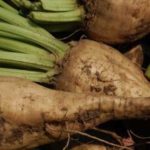Canadian and U.S. food inspectors have agreed on what they mean by a “field” in any restrictions they place on potato trade on account of potato cyst nematodes. The Canadian Food Inspection Agency (CFIA) and U.S. Department of Agriculture’s Animal and Plant Health Inspection Service (APHIS) on Tuesday announced new revisions to their Guidelines on Surveillance and Phytosanitary

Potato ‘fields’ clarified for cross-border trade

Plan aims to address economic problems of Manitoba’s Interlake
Our History: May 1966
Our May 19, 1966 issue led with coverage of the release of a 78-page master plan to address the chronic economic problems of the Interlake. This graphic contained the recommendations for land use in the different areas of the region. Improved education was recommended as the “paramount undertaking,” followed by resource development. Agriculture Minister George

Sask. opens farmland ownership review
Saskatchewan has kicked off public consultations for a review of its rules on investment in the province’s farmland. The consultation period, which runs until Aug. 10, is meant to help the province “understand who should, or should not be, allowed to own farmland in Saskatchewan,” Agriculture Minister Lyle Stewart said in a release Wednesday. At

P.E.I. farms and fisheries ministries merge
A reorganization of Prince Edward Island’s government departments will see agriculture split from forestry and instead paired with fisheries. Having returned to office in the May 4 election, Premier Wade MacLauchlan on Wednesday announced his new cabinet, appointing former education and transportation minister Alan McIsaac as minister of agriculture and fisheries. As the agriculture and

In this case, GMO technology is a failure
The glow-in-the-dark boys impress the ladies, but they can't fight off the competition
Purdue University researchers say that while males of a genetically modified zebrafish that glow in the dark are more attractive to females, their wild cousins end up with more breeding success. Glofish are a GM version of zebrafish with a transgene from a sea anemone, which gives them a neon glow. Animal science professors, William

Manitoba raises caps on cattle loan guarantee plan
Cattle producers and livestock associations in Manitoba will now be able to get provincial guarantees on larger loans to invest in feeder and breeder cattle. The province on Wednesday announced increased borrowing limits under its Manitoba Livestock Associations Loan Guarantee (MLALG), a program meant to allow producer members of livestock associations to get more favourable

Ottawa’s new GHG goal eyes fertilizer, chem sectors
The federal government’s new target, to cut the country’s greenhouse gas (GHG) emissions by 30 per cent below 2005 levels in the next 15 years, will involve new regulations on fertilizer and chemical companies’ output. Environment Minister Leona Aglukkaq announced the government’s new target and general plans on Friday in Winnipeg, but hasn’t yet specified

Study finds Manitoba ready for soy crushing
The rise of soybeans as a cash crop in and around Manitoba, and the availability of hogs to dine on soy meal, could support Western Canada’s first-ever soybean crushing plant, a new study finds. The feasibility study, run by Winnipeg-based Mercantile Venture Consulting and backed by the federal and Manitoba governments, shows a Manitoba crushing

Alta. beet growers, Rogers Sugar reach four-year deal
Sugar beet growers in Alberta will have a growing season in 2015 after all, having reached a last-minute deal with Canada’s lone sugar beet processor. Montreal-based Rogers Sugar on Wednesday announced its Lantic subsidiary has reached a new four-year agreement with the Alberta Sugar Beet Growers Association to supply the company’s beet sugar plant at

Requests for Ottawa to take over grain terminals
Our History: May 1909
This ad from the May 1909 The Grain Growers’ Guide offered Brandon-manufactured windmills ranging in price from $60 to $160. In 1908, the Nor-West Farmer had been purchased by the Grain Growers’ Grain Company (later United Grain Growers) and had become the official “organ” for the organization. Much of the May issue was devoted to

